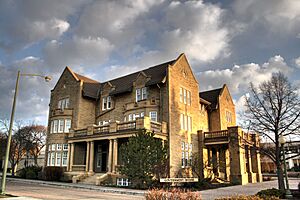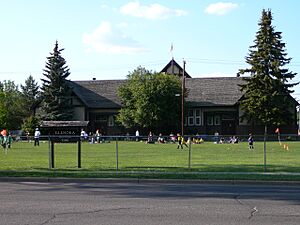Glenora, Edmonton facts for kids
Quick facts for kids
Glenora
|
|
|---|---|
|
Neighbourhood
|
|
| Country | |
| Province | |
| City | Edmonton |
| Quadrant | NW |
| Ward | 6 |
| Sector | Mature area |
| Area | |
| • Total | 1.63 km2 (0.63 sq mi) |
| Elevation | 670 m (2,200 ft) |
| Population
(2012)
|
|
| • Total | 3,514 |
| • Density | 2,155.8/km2 (5,583/sq mi) |
| • Change (2009–12) | |
| • Dwellings | 1,546 |
Glenora is a neighbourhood in Edmonton, Alberta, Canada. It is a residential area with nice views of the North Saskatchewan River valley.
Glenora is surrounded by other neighbourhoods. To the east, across Groat Road, is Westmount. To the north is North Glenora. McQueen is to the northwest. To the west is Grovenor, and to the southwest is Crestwood.
The people of Glenora have a Community League. It was started in 1949. This group helps run a community hall, tennis courts, basketball courts, and an outdoor ice rink. These are located at 136 Street and 104 Avenue.
Contents
How Glenora Started
The land where Glenora is today was once a farm. It belonged to Malcolm Groat, who has a road named after him. Later, in 1905, a rich grain merchant named James Carruthers bought the land. At that time, the city of Edmonton ended near a deep valley where Groat Road is now.
Carruthers wanted to build homes in the area. But it was hard for people to travel to and from the city. In 1909, he made a deal with the City of Edmonton. He would build a bridge over the valley. In return, the city would extend its streetcar service to Glenora. The bridge, called the Carruthers bridge, was finished in 1910. It helped the area grow and connect to the city. Today, 102 Avenue crosses this bridge.
After the bridge was built, a new official home for Alberta's lieutenant governors was started. This grand house, called Government House, was finished in 1913. A slowdown in building happened in 1913. However, many important people still wanted to live in Glenora. They liked being close to Government House. They also enjoyed the river valley views and easy access to the streetcar. The "West End," which included Glenora, had cleaner air than the east side of the city. This helped make Glenora a popular and well-off neighbourhood.
Interesting Places to Visit
Glenora has some important landmarks. These are located at the eastern end of the neighbourhood, overlooking Groat Road and the river valley.
Alberta Government House
Alberta Government House was once the home of the first six lieutenant governors of Alberta. A lieutenant governor is a person who represents the King or Queen in a Canadian province. Today, the Government House is used for important government meetings, parties, and dinners. A group of volunteers helps people learn about the history of Government House.
Royal Alberta Museum (Old Location)
The Royal Alberta Museum used to be in Glenora. It first opened in 1967 as the Provincial Museum of Alberta. In 2005, Queen Elizabeth II visited Alberta. During her visit, she allowed the museum to be called "Royal." So, its name changed to the Royal Alberta Museum. This museum closed its Glenora location in December 2015. It then moved to a new building downtown.
Government House Park
Below Alberta Government House and the old Royal Alberta Museum, you'll find Government House Park. This park is located in the river valley. It's a great place to enjoy nature.
Schools in Glenora
There are four schools in the Glenora neighbourhood.
- Glenora Elementary School is for younger students.
- Westminster Junior High School is for older students.
Both of these schools are part of the Edmonton Public School System.
- St. Vincent Catholic Elementary School is also in Glenora. It is part of the Edmonton Catholic School System.
- The Progressive Academy is a private school. It is located near the northeast part of the neighbourhood.




